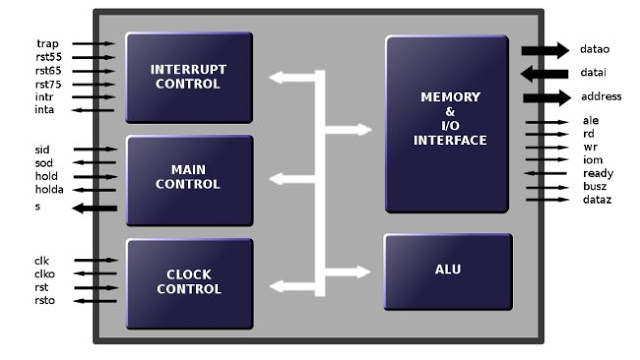


Instruction Register & Decoder*The processor first fetches the opcode of instruction from memory & stores opcode in the instructions registers, it is then sent to instruction decoder To perform logical operations like ANDOR NOT (Complement)*
#8085 ARCHITECTURE PC#
( In Jump or CALL, PC changes to address of subprogram)Stack is reserved area of the memory ( Temporary information storage - LIFO algorithm)After every stack operation SP points to next available location of the stack (Recent Entry)*ĪLU (Arithmetic & Logic Unit)To perform arithmetic operations like Addition & Subtraction Program counter & Stack PointerPC acts as a pointer to the NEXT instruction depends on upon nature of instruction ( 1 or 2 or 3 Bytes)PC automatically increments to point to the next memory during the execution of the present instruction. Also a borrow flag.Įxample : ADD B (A)A8H (B)EDH CY 95H (A)*1 ( 1 Negative 0 Positive)Z = Bit is set if ALU operation results a zero in the AccumulatorAC = Bit is set, when a carry is generated by bit 3 & passed on bit 4.P = Parity bit is set when the result has even number of 1s.CY = carry is set when result generates a carry. Special purpose Registers3.Flag*S = After the execution of an arithmetic operation, if bit 7 of the result is 1, then sign flag is set. Special purpose Registers1.Accumulator (A)Single 8-bit register that is part of the ALU Used inArithmetic/logic operations Load store As well as I/O operation One is Accumulator & other from Temp data Register Ex : ADD B ( A A+B ) W & Z (16) Ex : CALL, XCHG ( HL DE) Note *First B is transferred to Temp then add with AFirst DE transferred to WZ then exchange with HLThe programmer Can not access this temp Registers Temporary RegistersTemporary data Register The ALU has two inputs. *Data Pointer or Memory Pointer (M)High order registerLow order register General purpose RegistersSix general purpose 8-bit registers: B, C, D, E, H, LThey can also be combined as register pairs to perform 16-bit operations: BC, DE, HLRegisters are programmable (Data load, Move etc.) 8085 Microprocessor Architecture*AccumulatorArithmetic and logic UnitGeneral purpose registerProgram counterStack pointerTemporary registerFlagsInstruction register and DecoderTiming and Control unitInterrupt controlSerial Input/output controlAddress buffer and Address-Data bufferAddress bus and Data busIncrementer/Decrementer Address Latchĭ (8)E (8)B (8)C (8)Accumulator (A) (8)Flags (F) (8)H (8)L (8)1.General PurposeRegistersģ.SpecialPurposeRegisters4.Sixteen Bit Registers2.Temporary Registers(Temp Data, W & Z)Instruction Registers16 8 AddressData


 0 kommentar(er)
0 kommentar(er)
